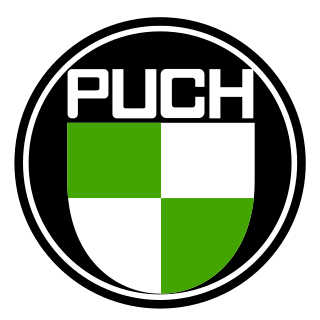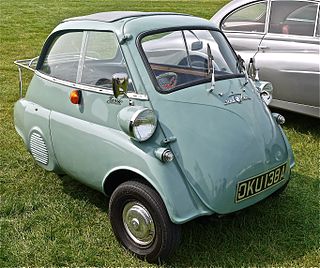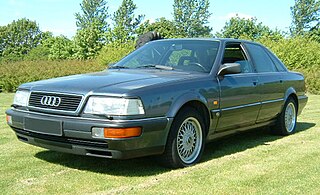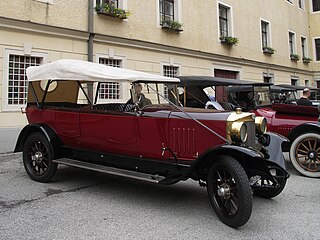
The Haflinger is a small, lightweight, four wheel drive, high mobility cab over vehicle about 3.5 m long and 1.5 m wide, powered by a 643 cc flat twin horizontally opposed, rear mounted, air-cooled engine. Weighing around 600 kg (1322.8 lb), the Haflinger can be lifted by four strong people and yet can carry a load of 500 kg (1102.3 lb). This truck falls into the category of the light utility vehicle. It was produced between 1959 and 1974 by the Austrian manufacturer Steyr-Daimler-Puch.

Zeta is a marque of automobile which was produced in Australia from 1963 to 1965 by South Australian manufacturing company Lightburn & Co.

The Fiat 500 is an economy / city car that was manufactured and marketed by Fiat Automobiles from 1957 until 1975. It was sold as a two-door semi-convertible or saloon car and as a three-door panel van or estate car.

The Fiat Panda is a city car manufactured and marketed by Fiat since 1980, currently in its third generation. The first generation Panda, introduced in 1980, was a two-box, three-door hatchback designed by Giorgetto Giugiaro and Aldo Mantovani of Italdesign and was manufactured through 2003 — receiving an all-wheel drive variant in 1983. SEAT of Spain marketed a variation of the first generation Panda under license to Fiat, initially as the Panda and subsequently as the Marbella (1986–1998).

Puch is a manufacturing company located in Graz, Austria. The company was founded in 1899 by the industrialist Johann Puch and produced automobiles, bicycles, mopeds, and motorcycles. It was a subsidiary of the large Steyr-Daimler-Puch conglomerate.

The Isetta is an Italian-designed microcar built under license in a number of different countries, including Argentina, Spain, Belgium, France, Brazil, Germany, and the United Kingdom. Because of its egg shape and bubble-like windows, it became known as a bubble car, a name also given to other similar vehicles.

Berkeley Cars Ltd was a British car manufacturer based in Biggleswade, Bedfordshire. The company produced economical sporting microcars with motorcycle-derived engines from 322 cc to 692 cc and front wheel drive between 1956 and 1960. About 4,100 cars had been sold before bankruptcy in 1960.

In automotive design, an RMR, or rear mid-engine, rear-wheel-drive layout is one in which the rear wheels are driven by an engine placed with its center of gravity in front of the rear axle, and thus right behind the passenger compartment. Nowadays more frequently called 'RMR', to acknowledge that certain sporty or performance focused front-engined cars are also "mid-engined", by having the main engine mass behind the front axle, RMR layout cars were previously just called MR, or mid-engine, rear-wheel-drive layout), because the nuance between distinctly front-engined vs. front mid-engined cars often remained undiscussed.

The Hindustan Ambassador is an automobile that was manufactured by Indian manufacturer Hindustan Motors from 1957 to 2014, with improvements and changes over its production lifetime. The Ambassador was based on the Morris Oxford series III model, first made by Morris Motors Limited at Cowley, Oxford in the United Kingdom from 1956 to 1959.

The Audi V8 is a four-door, full-size luxury sedan, designed, manufactured and marketed by Audi in Germany from 1988 to 1993, as the company's flagship. As the first car from Audi to use a V8 engine, also was the first Audi to combine a quattro system with an automatic transmission. Early cars used 3.6-litre V8s, while later cars featured a 4.2-litre version of the engine. The Audi V8 was replaced by the Audi A8 in 1994, although the A8 was not marketed in North America until 1996.

A transverse engine is an engine mounted in a vehicle so that the engine's crankshaft axis is perpendicular to the direction of travel. Many modern front-wheel drive vehicles use this engine mounting configuration. Most rear-wheel drive vehicles use a longitudinal engine configuration, where the engine's crankshaft axis is parallel with the direction of travel, except for some rear-mid engine vehicles, which use a transverse engine and transaxle mounted in the rear instead of the front. Despite typically being used in light vehicles, it is not restricted to such designs and has also been used on armoured fighting vehicles to save interior space.
Henry Meadows, usually known simply as Meadows, of Wolverhampton, England were major suppliers of engines and transmissions to the smaller companies in the British motor industry. Founded in 1920 in Park Lane, Wolverhampton, as a car gearbox maker, they expanded into petrol engines in 1922 and in the 1930s built a large factory in Fallings Park, Wolverhampton.
Lloyd Cars Ltd was a British motor manufacturer, founded by Roland Lloyd (1904–1965), son of a garage owner, and based in Patrick Street, Grimsby, Lincolnshire, England between 1936 and 1951. Two models were made, separated by World War II; the company was unusual for a small manufacturer in making nearly all components in-house. After car production ceased the company continued in general engineering until 1983. During World War II the company made components for Rolls-Royce Merlin aircraft engines.

The Mark I Mini (1959–1967) was the first version of British Motor Corporation's Mini model. It is characterised by its sliding windows, external door hinges and "moustache" grille. In the United Kingdom the Mark I was produced between 1959 and 1967 at the Longbridge Plant near BMC's headquarters, with production in Australia continuing until 1970. The Mini Mark I was sold under both Austin and Morris marque names.

Dante Giacosa was an Italian automobile designer and engineer responsible for a range of Italian automobile designs — and for refining the front-wheel drive layout to an industry-standard configuration.

Bond Minicar is a series of economical three-wheeled microcars which were manufactured by the British car manufacturer Sharp's Commercials Ltd, in Preston, Lancashire, between 1949 and 1966.

Steyr was an Austrian automotive brand, established in 1915 as a branch of the Österreichische Waffenfabriks-Gesellschaft (ÖWG) weapon manufacturing company. Renamed Steyr-Werke AG in 1926 and merged with Austro-Daimler and Puch into Steyr-Daimler-Puch AG, it continued manufacturing Steyr automobiles until 1959.

The SEAT Exeo is a large family car and flagship model, that was built by the Spanish car manufacturer SEAT, subsidiary of the Volkswagen Group. The Exeo is an Audi A4 (B7) with a redesigned front and rear.
The Coronet was a three-wheeled microcar with a rear-mounted 328 cc (20 cu in) Excelsior two-cylinder, two-stroke 18 metric horsepower (13 kW) engine.

Morris Twelve is a model of Morris car introduced without fanfare in the autumn of 1934 as little more than a larger engined Morris Ten Four for which just another £5 was asked. The chassis and body were of the slow-selling longer wheelbase Ten Six. The engine though awarded a tax rating of 11.98 hp had a cubic capacity of 1548cc compared with Morris's 1292cc (10 hp) Ten Four and 1378cc (12.09 hp) Ten Six.























